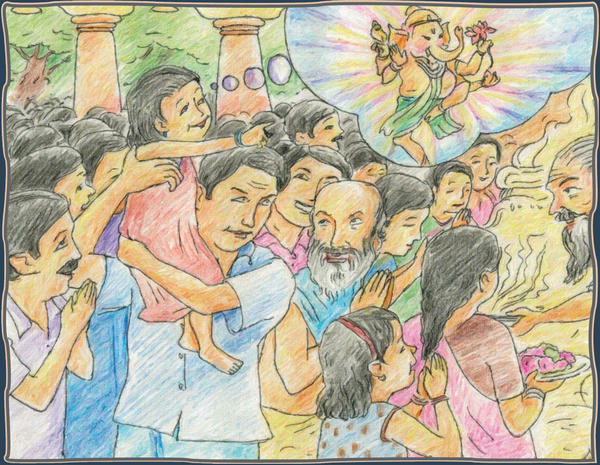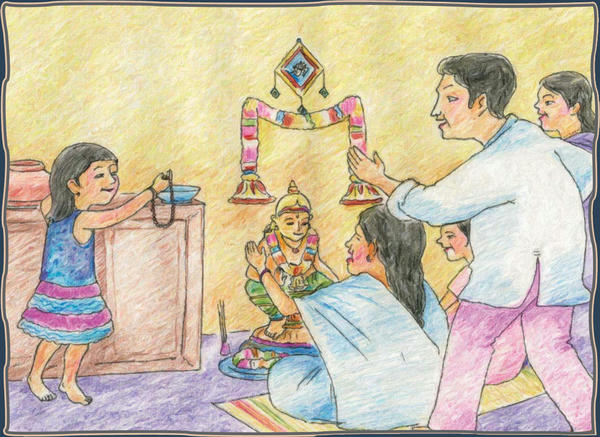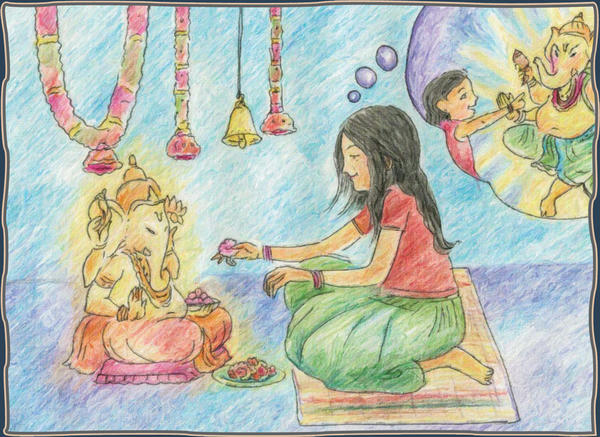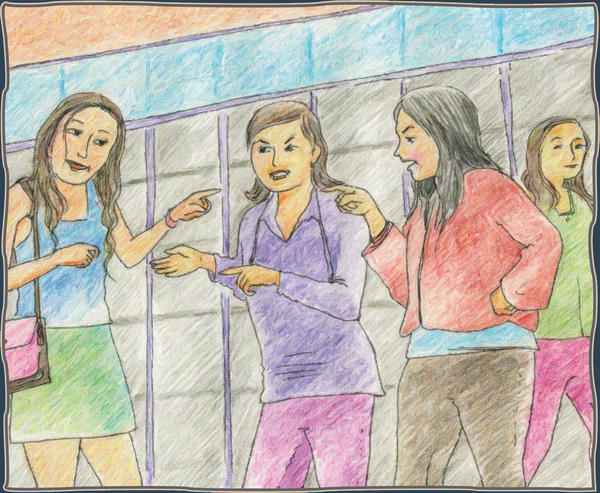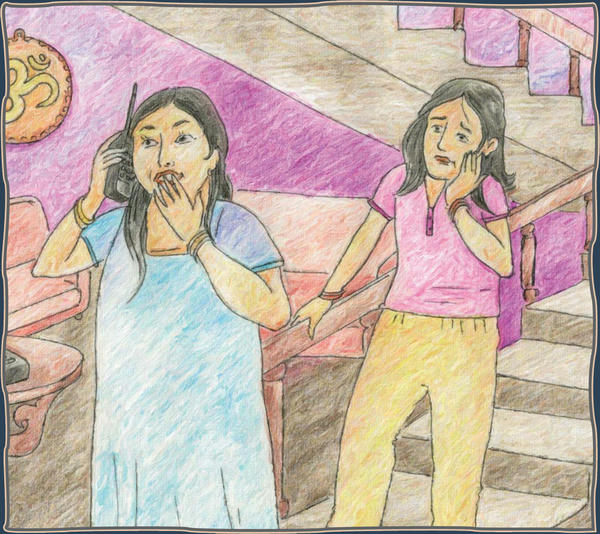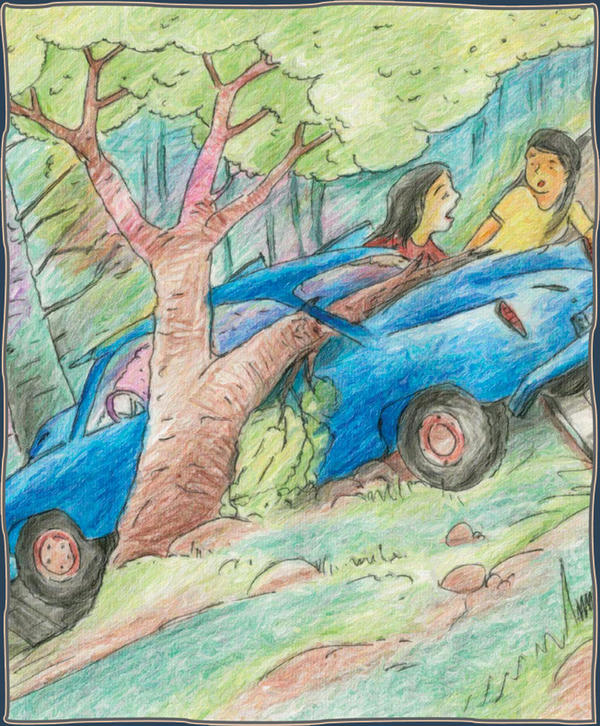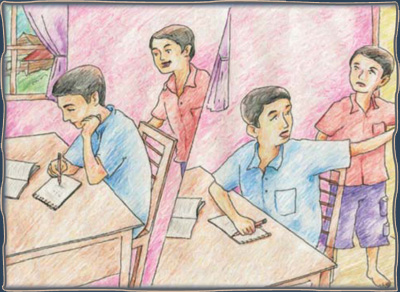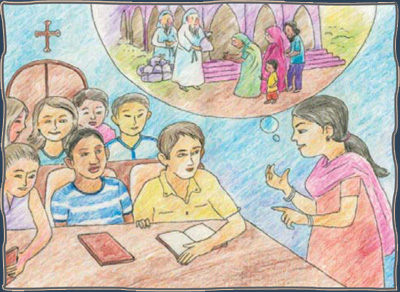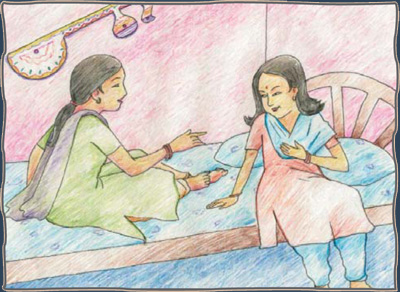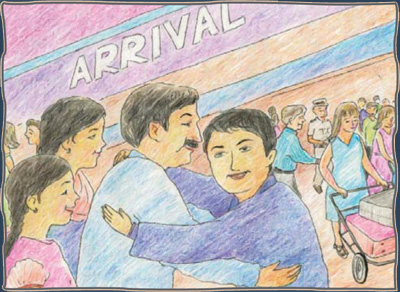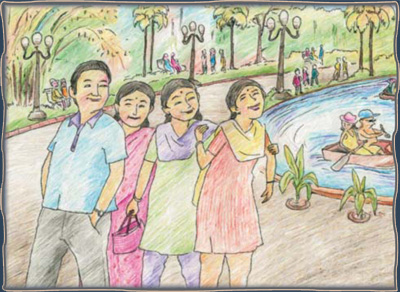
Growing Up Hindu
Morality stories for Hindu youth§
BY SATGURU BODHINATHA VEYLANSWAMI§
Parents are one’s first guru. They teach by example, explanation, giving advice and direction. Very often parents come to me for advice on the subject of raising their children as good Hindus. In response, I developed a list of ten key character qualities to develop in a child that were published in our Jul/Aug/Sep 2002 issue. These ten qualities—positive self-concept, perceptive self-correction, powerful self-control, etc.—are basic qualities needed by anyone who wants to be happy, religious and successful when they reach adulthood. For this first book of the Hindu Youth Series, I requested our team of editors, writers, artists and reviewers to create a set of ten stories illustrating how these qualities might be learned when growing up. They are set in modern US, India, Malaysia and Canada and intended for youth 14 and up—the time when we start to take responsibility for our own actions and when these important qualities should manifest. §
Each story illustrates one concept, generally as instilled by the parents when their child is young and then as demonstrated in the youth when faced with a challenging situation. For example, the first quality, positive self-concept, is illustrated through the story of a young boy who successfully deals with a bully at school. Another focuses on two sisters who finally learn to get along by putting into practice “perceptive self-correction” as taught to them when they were children. A third, set in Malaysia, discusses the parallel lives of two sets of cousins, one that was taught “playful self-contentment” as children and the other that was driven only to succeed, at the cost of their own happiness later in life. §
STORIES BY ANURADHA MURALI  ILLUSTRATIONS BY RAJEEV N.T.§
ILLUSTRATIONS BY RAJEEV N.T.§
How Lord Ganesha Saved Little Usha
Usha and Anjana’s parents, Umesh and Swati, loved the Hindu way of life, and they promised one another they would instill that same pious character in their daughters. As soon as each girl was old enough, she was given something to do at the family’s daily morning puja, starting with fetching the tray of flowers or filling the water bowl. From an early age the sisters loved the worship, the chanting, singing and incense—not to mention the scrumptious prasadam! §
They first went to India when Usha was just six and Anjana was nine. The girls were excited to arrive in Mumbai right on time for the annual Ganesha festival. As the family drove to the ceremonies from the airport, Usha and Anjana lit up at the sight of the huge pandals, temporary temples, set up in the busy streets. Each featured a large and magnificent Ganesha created just for the eleven-day festival. §
This story, excerpted from Growing Up Hindu, illustrates the virtue of pious character, one of ten basic qualities needed by anyone who wants to be happy, religious and successful when they reach adulthood. §
Even more exciting was their experience at the famous Siddhi Vinayaka temple. When they arrived, it was completely packed with people. After standing in the long line for over an hour, they moved near the inner sanctum, where they could finally see Ganesha—except Usha, who was too short. “Lift me up, Daddy, lift me up,” she pleaded, tugging on his pant leg.§
Dad lifted her up high so she could see Ganesha.§
Suddenly Usha yelled, “He’s dancing!” §
“Who’s dancing?”§
“He’s dancing,” Usha replied, pointing at Ganesha. §
“What do you mean? That’s a stone statue—how can it move?”§
“No, He’s dancing!” she insisted. “I can see Him moving His arms and trunk and rocking back and forth!”§
Usha was nearly shouting in her excitement, and nearby devotees took notice. §
An elderly lady next to Dad asked, “What is she saying?”§
“She’s seeing the God dance,” replied a man to the lady’s right.§
“Is it so?! Jai Ganapati!”§
By now the priest had come over. Offering namaskara to Usha, he announced, “We have all been blessed today by this little girl’s vision.” §
The family was still chattering about it when they arrived at the home of Umesh’s parents. After greeting their son and his family with arati at the door, Umesh’s parents took the family to the shrine room. At that point the day’s second unusual event took place. Usha walked over to a shelf near the altar and picked up a strand of prayer beads. “These are mine!” §
Her dad told her softly, “I don’t think so. You have never even been here before. So, how could they be yours?”§
“They are mine! I use them every day.”§
Umesh’s mother looked at her husband, “Those beads belonged to my mother, the very person Usha was named after.”§
“Do you suppose Usha is your mom reborn?”§
Suddenly, Usha put the beads back and ran into the next room. Bewildered, the adults followed her.§
“This has been a strange day!” exclaimed Swati.§
“Where did the kitchen go?” Usha called out from the end of one hallway.§
“Now what?” asked Dad.§
Umesh’s father offered an explanation. “This was Grandma Usha’s home, but it has since been remodeled. Your daughter is standing right where the kitchen used to be! How could she know? Even you didn’t know that.”§
The next day, Dilip came for a visit. He was a close friend of the family and a talented astrologer. They explained Usha’s behavior. The following day, he returned. Excitedly, he announced, “I have studied their charts, and I believe they are indeed the same soul. This is wonderful! But I also have to caution you about something.”§
“What’s that?” asked Mom.§
“Usha will be naturally religious, but she will become rebellious as a teen. You should watch for that and be ready to guide her wisely.”§
After a week in Mumbai, the family headed back to America. Usha’s memory of her great-grandmother’s house and the prayer beads faded quickly, and she forgot all about it by the time she was eight. §
As they grew up, Usha and her sister loved the temple, the festivals, the singing and their twice-weekly bharata natyam classes. They were two of the best students in their weekly Hinduism class. But, just as the astrologer had predicted, all this changed for Usha when she began high school, the same year Anjana left home for college. §
The young Usha was both pretty and talented. She started to spend more time with a new circle of friends, the school’s “popular” girls. None of them was particularly religious, and Usha kept quiet as they entertained each other by mocking the beliefs of Christian students and gossiping about the school’s two Muslims.§
It was perhaps natural that she began doubting her own beliefs. Around her friends Usha never uttered a word about her faith. She was afraid they might not like her if they knew she was a practicing Hindu. Maybe Hinduism was just another religion that should be left in the past, she pondered, just as her friends frequently said about the other faiths. §
Usha walked a fine line to be accepted by this clique of girls. She never mentioned how conservative her parents were; they expected her to not date until she was 21! Usha went to a few parties with her friends, but avoided showing interest in any of the boys. §
One spring, Usha and her friends made plans for a three-day holiday weekend at Yosemite Park, one of the most beautiful places in California. Nervously, Usha told Mom and Dad about the trip, asking if she could go. Fortunately for Usha, it was a chaperoned event, with Susan’s parents going as well as several other adults. Otherwise, Dad would have had none of it! As it was, he was not objecting, but Mom was visibly uncomfortable about it. She knew the other girls could be sneaky and manage to get into mischief despite the chaperones. “We should ask Lord Ganesha about this.”§
“How are we going to do that?” Usha challenged, worried they would not let her go. §
The Value of Pious Character§
Pious character is evident when we naturally treat others with kindness, generosity and appreciation. It is fulfilled when we seek the blessings of God, Gods and guru throughout life. How can this be cultivated in children? It is through the parents’ demonstrating these qualities themselves: children learn that this behavior is expected of them by observing their parents’ actions. It is by referring often to the ten observances (niyamas) of Hinduism’s Code of Conduct and pointing out their relevance in daily life, on TV and in movies. §
The niyamas are remorse, contentment, giving, faith, worship of the Lord, scriptural listening, cognition, sacred vows, recitation and austerity. Pious character is nurtured by teaching the child to worship and pray in the home shrine or at the temple before important events, such as beginning a new school year or before final examinations. Pious conduct brings into our children’s lives the joys of divine blessings. My Gurudeva outlined the ideal: “Hindu children are always treated with great respect and awe, for one does not always know who they are. They may be incarnations of a grandmother, grandfather, aunt or uncle, dearly beloved mother, sister, brother, respected father, a yogi or rishi returned to flesh to help mankind spiritually. We must ask, ‘Who are these souls? What is their destiny in this life? How can I help?’ ”§
“How can you, of all people, ask that?” said Mom. “It was you who saw Him dancing in the temple!”§
“That was a long time ago, Mom, and maybe it didn’t really happen.”§
“Oh, it happened alright,” said Mom. “The entire temple practically came to a stop as a result. I know He will give us a sign. Just you wait.”§
They sent a written prayer to Ganesha through the temple’s sacred fire and agreed to allow Him a week for a response. After all, He might be busy with other concerns.§
All that week the girls talked and giggled about the trip. Susan’s parents would take their SUV, and Susan, Usha and Melissa would follow in their sedan. §
On Friday morning, Susan caught Usha in the hall before their first class. “Hey, Usha, we decided to leave this evening instead of tomorrow. I hope you are ready.”§
Usha froze. There had been no sign from Ganesha, so she had not received permission. Still, she reasoned, no sign didn’t necessarily mean “no,” so Mom will probably agree. “I’m ready,” she told Susan.§
“By the way, I invited Nicole to join us. She’s been wanting to get in with our group, and this is a chance to get to know her.”§
This was a bombshell for Usha. Nicole had been trying to join with the girls all year, but Usha didn’t like her and had managed to keep her out. Back in eighth grade, they had gotten into quite a fight when Nicole started some gossip about her that was completely untrue. Nicole was also a bit of a sneak, and Usha was sure she had cheated on at least once important test this year. As far as Usha knew, Susan didn’t like Nicole either, but obviously something had changed.§
Usha replied angrily, “But you know how I feel about her! Why did you call her?” §
“Look, I didn’t really have a choice. She would think I was mean if I left her out once she found out about it. She’s definitely coming.” §
“In that case, count me out.” Usha abruptly walked away.§
What Is Worship?§
FROM THE TEACHINGS OF SATGURU SIVAYA SUBRAMUNIYASWAMI§
Worship could be defined as communication on a very high level: a truly sophisticated form of “channeling,” as New-Age people might say; clairvoyant or clairaudient experience, as mystics would describe it; or heart-felt love interchanged between Deity and devotee, as the ordinary person would describe it. Worship for the Hindu is on many levels and of many kinds. In the home, children worship their father and mother as God and Goddess because they love them. The husband worships his wife as a Goddess. The wife worships her husband as a God. §
In the shrine room, the entire family together worships images of Gods, Goddesses and saints, beseeching them as their dear friends. The family goes to the temple daily, or at least once a week, attends seasonal festivals and takes a far-off pilgrimage once a year. Worship is the binding force that keeps the Hindu family together. On a deeper level, external worship is internalized, worshiping God within through meditation and contemplation. This form of worship leads into yoga and profound mystical experiences.§
All Hindus have guardian devas who live on the astral plane and guide, guard and protect their lives. The great Mahadevas in the temple that the devotees frequent send their deva ambassadors into the homes to live with the devotees. A room is set aside for these permanent unseen guests, a room that the whole family can enter and sit in and commune inwardly with these refined beings who are dedicated to protecting the family generation after generation. Some of them are their own ancestors. All Hindus are taught from childhood that the guest is God, and they treat any guest royally who comes to visit. Hindus also treat God as God and devas as Gods when they come to live permanently in the home. §
The ideal of Ishvarapujana, worship, is to always be living with God, living with Siva, in God’s house, which is also your house, and regularly going to God’s temple. This lays the foundation for finding God within. When we are living in God’s house, it is easy to see God as pure energy and life within every living form, the trees, the flowers, the plants, the fire, the Earth, humans, animals and all creatures. When we see this life, which is manifest most in living beings, we are seeing God Siva. Many families are too selfish to set aside a room for God. Though they have their personal libraries, rumpus rooms, two living rooms, multiple bedrooms, their superficial religion borders on a new Indian religion. Their shrine is a closet, or pictures of God and Goddesses on the vanity mirror of their dressing table. The results of such worship are nil, and their life reflects the chaos that we see in the world today. §
It is often said that worship is not only a performance at a certain time of day in a certain place, but a state of being in which every act, morning to night, is done in Siva consciousness, in which life becomes an offering to God. Then we can begin to see Siva in everyone we meet. When we try, just try—and we don’t have to be successful all the time—to separate the life of the individual from his personality, immediately we are in higher consciousness and can reflect contentment and faith, compassion, steadfastness and all the higher qualities, which is sometimes not possible to do if we are only looking at the external person. This practice, of Ishvarapujana sadhana, can be performed all through the day and even in one’s dreams at night. §
Meditation, too, in the Hindu way is based on worship. It is true that Hindus do teach meditation techniques to those who have Western backgrounds as a mind-manipulative experience. However, a Hindu adept, rishi or jnani, even an experienced elder, knows that meditation is a natural outgrowth of the charya, kriya and yoga paths. It is based on a religious foundation, as trigonometry is based on geometry, algebra and arithmetic. If you are worshiping properly, if you take worship to its pinnacle, you are in perfect meditation. §
We have seen many devotees going through the form of worship with no communication with the God they are worshiping or even the stone that the God uses as a temporary body. They don’t even have a smile on their face. They are going through the motions because they have been taught that meditation is the ultimate, and worship can be dispensed with after a certain time. Small wonder that when they are in meditation, their minds are confused and subconscious overloads harass them. Breathing is irregular, and if made regular has to be forced. Their materialistic outlook on life—of seeing God everywhere, yet not in those places they rationalize God can never possibly be—contradicts their professed dedication to the Hindu way of life. §
Yes, truly, worship unreservedly. Perfect this. Then, after initiation, internalize that worship through yoga practices given by a satguru. Through that same internal worship, unreservedly, you will eventually attain the highest goal. §
When Usha walked in the front door of her home, Mom took one look at her face and asked, “Usha, what happened?”§
“Susan invited Nicole on the camping trip. Now I’m not going!”§
Mom knew how much Usha had wanted to go and how excited she had been. “Maybe this is the sign from Ganesha.” §
Usha looked at Mom. “What are you talking about? What has Ganesha got to do with this? Susan’s just mean.” She ran to her room and slammed the door. §
At 3:00 in the morning, Usha woke up to the shrill ring of the phone. Rubbing her eyes, she heard Mom answering the call. She felt a chill run down her spine as her mother asked, “Which hospital?”§
She rushed down the stairs, now feeling quite afraid. Mom put down the phone and said, “Usha, Susan’s car crashed.” §
“Oh, no!”§
“The girls are safe. They are at a hospital near Yosemite getting treated for minor cuts. Susan’s parents are with them, and they’re driving back this morning. They’re all too shaken up to continue the camping trip.”§
Dad, Mom and Usha met the group at Susan’s house. Mom brought some idlis she had cooked early that morning. The families were good friends, and she knew they would love some home-cooked Indian food after their ordeal. §
Still upset, Susan explained what happened. “We were driving slowly because it was already dark, but Nicole kept goading me to drive faster. It was an uphill drive, you know, and when I rounded a curve, I lost control and we went off the shoulder. Fortunately, the car slid into two trees—otherwise we would have gone off a cliff! I’ll tell you, there’s nothing like the feeling of that seat belt tightening around you when your car is flying off the road, and ‘boom,’ the airbag blowing up in your face. We are lucky to be alive.”§
“Wow, that must have been scary!”§
“It was, Usha. But at least no one was seriously hurt. When I looked around the car, I saw that a tree branch had come through the rear window and punctured the back seat. If you had come on the trip, too, then two of us would have been in the back instead of all in the front. Someone could have died!”§
When Usha reached home, she went to the shrine room and put a flower before Ganesha. “Thank you for getting in the way of my going on that trip. I’m sorry I forgot that you look after me.” Suddenly she vividly remembered Ganesha dancing for her years ago. It was as if she was seeing it all for the first time. §
Returning to the living room, Usha sat with her parents. “You were right to question this trip. You knew I might follow the lead of the other girls. By leaving the matter up to Ganesha, you helped me reconnect with Him. I also realized that Susan and her friends are not right for me. They invited Nicole, I found out, because she promised to get them wine and beer for the weekend. I need to associate with a group that shares our values.”§
Three years later Usha left home for university. Arriving at her new dorm, the first thing she did was hang up the big poster of Ganesha from her room at home. She never failed to pray to Him each day. She knew He was watching over her.§
Other Fun Stories in the Series§
At right are previews of six more of the books’ ten stories in which youth are challenged to put into action invaluable skills instilled early in their life—skills such as self-correction, self-confidence, proficiency in conflict resolution—as they face real-life situations such as sibling rivalry, conflict at school, family contention and confronting prejudice.§
Where to Get the Book§
Growing Up Hindu, Book One of Modern Stories for Hindu Youth, is 88 pages long and profusely illustrated with pastel pencil art by Rajeev N.T. of Kerala. It is available for $20 as hardcover (ISBN: 978-1-934145-43-2) and in popular e-book formats through Amazon.com and Apple’s iBookstore. Order at minimela.com or through Amazon.com.§
The Jealous Older Brother§
Trouble starts between two brothers as the younger one surpasses the older in math skills. In this story, the resulting conflict is worked out over time with parental help which instills a positive self concept in the child, allowing him to acknowledge strengths and weaknesses without falling into jealousy or envy.§
Little Miss Gandhi§
Trained as a child to work out disputes with her younger brother fairly and without parental help, Amala takes on and amicably solves a much bigger challenge when an aggressive Christian group at school target a shy new girl with a deceptive strategy known as friendship evangelism.§
Learning to Get Along§
Two sisters make fighting a way of life until they realize one day just how much their spats hurt their mother. They then set out to put into action a skill taught them early in life—perceptive self-correction. They succeed by systematically talking through their differences and arriving at a workable solution for each difficult situation. §
The Value of a Hug§
Raj hated getting hugged by his father every day, especially as a taller-than-dad teen. But he gains a new appreciation for his family’s closeness during his first semester at college when his roommate bitterly recounts his family’s multiple divorces, remarriages and unending conflicts. §
Living a Fulfilling Life §
A tale of two families: in one the parents push their children to ever higher material goals, in the other mother and father emphasize a wise balance between worldly accomplishment, religious living and enjoying life. In a final deathbed scene, the children of both families come together to share the wisdom of the balanced life.§



